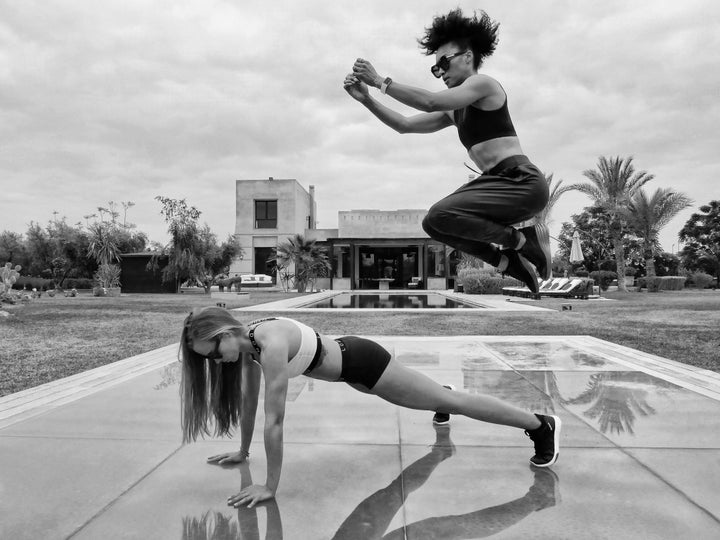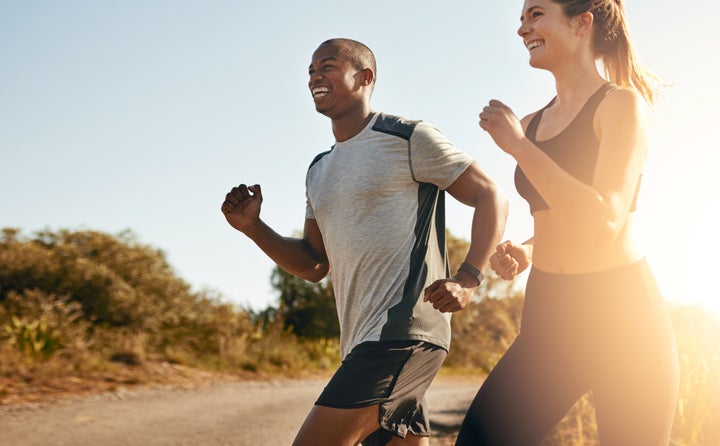When it comes to acronyms, it seems the fitness world is constantly inventing new ones: HRM (heart rate monitor), BPM (beats per minute), BMR (basal metabolic rate), AMRAP (as many reps as possible). And that’s naming just a few.
Here’s another one to familiarise yourself with: HIIT, aka high-intensity interval training. An efficient and effective workout, it cuts your gym time by more than half while amping up that calorie burn. No wonder everyone is queuing up to do these workouts, especially those with ultra-hectic schedules. And since you don’t need any equipment, you can squeeze in a HIIT workout anytime, anywhere.
And the research backs it up: numerous studies have found that HIIT workouts can improve aerobic capacity quicker than traditional endurance training and help people burn more fat in less time.
We chatted to personal trainer Christina Howells, founder of That Girl Method, to find out everything we need to know about HIIT – and if it’s the right workout for us.

So, What You Actually Do In A HIIT Workout?
HIIT involves short bursts of very intense activity interspersed with recovery periods of lower-intensity activity or short periods of rest. The good news? The whole workout lasts 20-30 minutes - in traditional Tabata training, each exercise lasts only four minutes (you work out intensely for 20 seconds, rest for 10 seconds and then repeat. Eight times).
“HIIT workouts usually prescribe specific work/rest periods as well as a given number or rounds,” says Howells. “The beauty of training and rest-interval is that it can be modified to suit the individual according to their medical history, fitness ability and goals.”
So you can choose a HIIT activity you enjoy, whether that’s running up the stairs, and then walking back down, or doing jumping movements like burpees interspersed with low-intensity moves like planks. Rower and biker sprints are another way to get your HIIT fix; just follow with a short recovery of non-activity.

Is HIIT For Everyone?
Beginners beware: HIIT training isn’t going to magically turn you from couch potato to fitness pro overnight.
“HIIT, like any other exercise, is not something you just wake up and do, especially at all-out intensity! Let’s face it, you would not run a half marathon without building up to it and so the same applies for HIIT,” cautions Howells.
For beginners, she recommends building up a steady cardio regime for 30 minutes at least five times a week, as well as mobility and strength training classes to improve function.
She then suggests choosing a simple activity like walking, stationary biking, rowing or jogging on the spot, working as hard as you can for 30 seconds, followed by low-intensity or rest for 30 seconds. Repeat six-10 rounds.
“You need to be mindful when you start a new form of exercise workout to find your optimal individual intensity at the present moment and not compete with others.
“If you are sedentary right now, then first start moving more and aim to build continuous movement for at least 30 minutes at a steady state before you even think about increasing the intensity. Build slowly towards your goals and savour your achievements!” she advises.
What Are Some Of The Benefits Of HIIT Training?
HIIT has myriad benefits, both physiological and psychological (and yep, science agrees). Research has found that it promotes improved blood sugar regulation, decreasing your risk of insulin resistance and Type Two diabetes. It is known to improve body composition, helping the body to burn fat and preserving muscle mass.
“You burn more calories during a HIIT workout compared to steady state cardio and because your intensity is high you will benefit from EPOC (excess post-exercise oxygen consumption), often referred to as the “afterburn,” which continues for a few hours after activity stops,” explains Howells. Yep, that’s as good as it sounds: you’ll continue to burn cals long after you’ve left the gym.
HIIT can also help to increase your VO2 max (your body’s ability to consume oxygen), which will help improve your fitness levels, as well as improving vascular function and preserving mitochondrial function.
“Exercise full stop is great for our mental health. HIIT workouts will not give you that think time but they will still give you the endorphin rush. You will also feel a great sense of accomplishment at the end of the session, which can improve your overall self-confidence and body esteem,” says Howells.

What Is The Best Way To Integrate HIIT Into Your Workout Regime? And Where Can I Find HIIT Classes?
While HIIT has much to recommend it, it shouldn’t be your only form of working out.
“These workouts are exhaustive and are meant to form part of your fitness regime rather than your only mode of activity. However fit you may be, if you focus on only one thing then other components of fitness will decline,” says Howells.
Make sure to allow for plenty of recovery time between HIIT sessions, and balance out your HIIT workouts with other types of exercise that improve mobility and strength. This is the best way to avoid injury.
The good news is, if you’re looking for a HIIT workout, you’re likely to find one at a gym near you, from leisure centres offering Les Mills classes to specialised gyms like Barry’s Bootcamp in London. You can also find HIIT bursts combined with your favourite activity like Pilates or barre (available at Barrecore).
You don’t even need to leave the house to get your HIIT fix: Howell’s That Girl Method, a 12-week fitness plan, focuses on full-body movements that involve the body as a whole, rather than isolated moves so you won’t overtax the cardiovascular system.
Just remember another fitness acronym for when you’ve mastered HIIT: S-HIIT, (the “S” at the beginning stands for “super”). Ready for an even more intense workout?
Enjoy the ride.